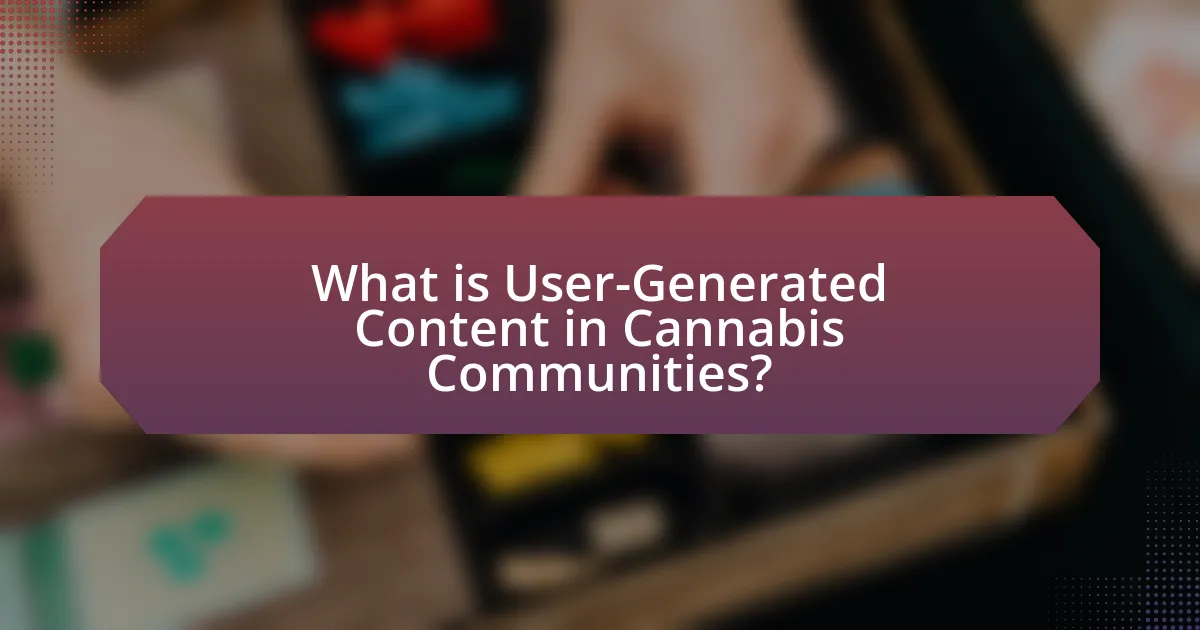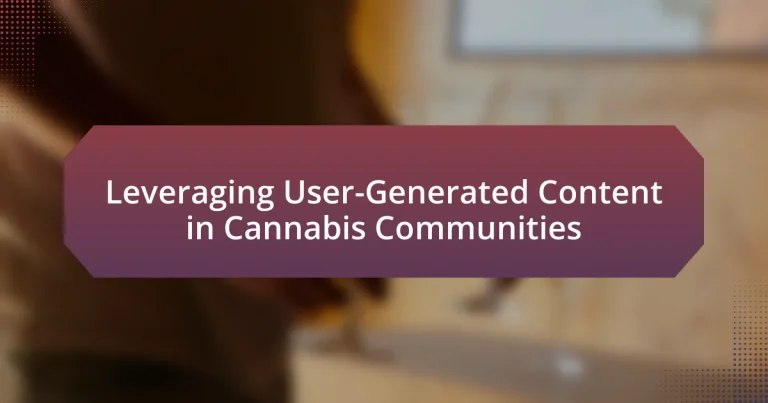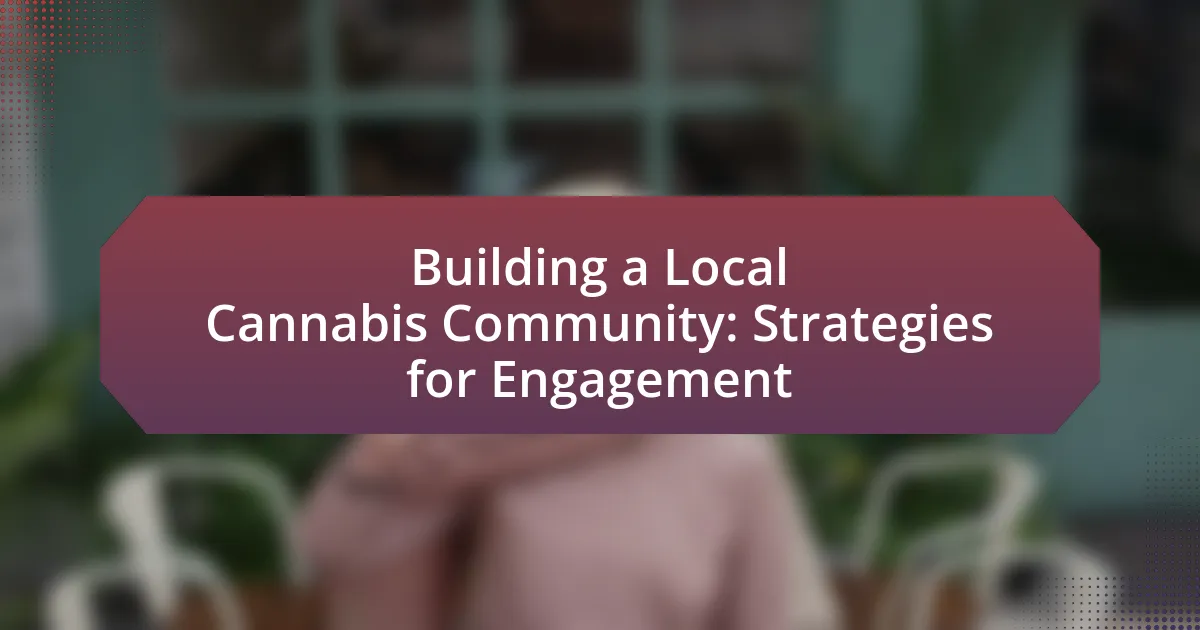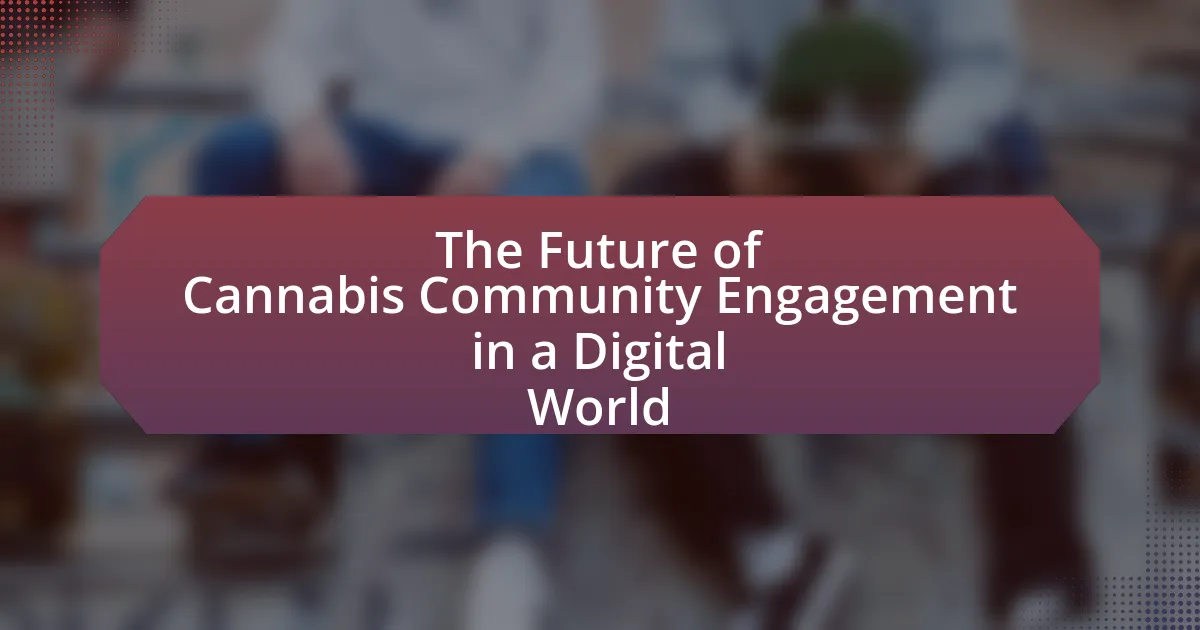User-Generated Content (UGC) in cannabis communities encompasses content created by individuals, such as reviews, photos, and testimonials, that reflects personal experiences with cannabis. This article explores the significance of UGC in shaping community perceptions, influencing purchasing decisions, and fostering trust among users. It examines how UGC manifests in these communities, the types of content commonly created, and the engagement strategies employed by users. Additionally, the article addresses the challenges faced by cannabis communities regarding legal restrictions and misinformation, while highlighting best practices for brands to leverage UGC effectively to enhance authenticity, customer loyalty, and community engagement.

What is User-Generated Content in Cannabis Communities?
User-Generated Content (UGC) in cannabis communities refers to any content created and shared by individuals rather than brands or organizations, specifically related to cannabis culture, products, and experiences. This content can include reviews, photos, videos, blog posts, and social media interactions that reflect personal opinions and experiences with cannabis. UGC plays a crucial role in shaping community perceptions and influences purchasing decisions, as it often provides authentic insights and peer recommendations that are valued more than traditional advertising. Studies show that 79% of people say user-generated content highly impacts their purchasing decisions, highlighting its significance in cannabis communities where trust and shared experiences are paramount.
How does User-Generated Content manifest in these communities?
User-Generated Content (UGC) in cannabis communities manifests primarily through shared experiences, product reviews, and educational resources created by community members. These contributions often include personal stories about cannabis use, cultivation tips, and recommendations for strains or products, fostering a sense of trust and authenticity among users. For instance, platforms like Leafly and Reddit feature extensive user-generated reviews and discussions that guide consumers in their purchasing decisions, demonstrating the impact of UGC on community engagement and knowledge sharing.
What types of content are commonly created by users?
Users commonly create content such as reviews, testimonials, photos, videos, and blog posts related to cannabis products and experiences. This type of user-generated content is prevalent in cannabis communities, where individuals share their personal insights and recommendations. For instance, a study by the Pew Research Center found that 72% of social media users engage with content that includes personal experiences, which highlights the importance of user contributions in shaping community knowledge and preferences.
How do users engage with this content?
Users engage with user-generated content in cannabis communities primarily through sharing personal experiences, reviews, and recommendations. This engagement often occurs on social media platforms, forums, and dedicated cannabis websites, where users post photos, videos, and written testimonials about their cannabis use. According to a study by the Journal of Cannabis Research, 70% of cannabis users reported that they rely on peer reviews and community feedback when making purchasing decisions. This reliance on shared content fosters a sense of community and trust among users, enhancing their overall experience and encouraging further interaction.
Why is User-Generated Content important for Cannabis Communities?
User-Generated Content (UGC) is important for cannabis communities because it fosters trust and engagement among members. UGC allows individuals to share personal experiences, product reviews, and cultivation tips, which enhances the sense of community and provides valuable insights. According to a study by the Content Marketing Institute, 79% of people say user-generated content highly impacts their purchasing decisions, indicating that authentic content from peers is more influential than traditional marketing. This trust in peer recommendations is particularly crucial in the cannabis industry, where consumers often seek reliable information in a rapidly evolving market.
What role does it play in community building?
User-generated content plays a crucial role in community building within cannabis communities by fostering engagement and trust among members. This type of content allows individuals to share personal experiences, knowledge, and insights, which enhances the sense of belonging and connection. For instance, studies show that communities with high levels of user-generated content experience increased interaction rates, leading to stronger relationships among members. Additionally, user-generated content serves as a valuable resource for education and advocacy, empowering community members to make informed decisions about cannabis use and policy.
How does it influence consumer behavior?
User-generated content (UGC) significantly influences consumer behavior by enhancing trust and engagement within cannabis communities. Research indicates that 79% of consumers say user-generated content highly impacts their purchasing decisions, as it provides authentic insights and experiences from real users. This authenticity fosters a sense of community and belonging, encouraging potential buyers to trust the product and brand more than traditional advertising methods. Additionally, UGC often showcases diverse product uses and benefits, which can lead to increased interest and exploration of cannabis products among consumers.
What challenges do Cannabis Communities face with User-Generated Content?
Cannabis communities face significant challenges with user-generated content, primarily due to legal restrictions and misinformation. The legal status of cannabis varies widely across regions, leading to uncertainty about what content can be shared without legal repercussions. For instance, in jurisdictions where cannabis remains illegal, users may face penalties for sharing content related to its use. Additionally, misinformation can proliferate within these communities, as users may share unverified claims about cannabis products, which can mislead others and undermine trust. A study by the Journal of Cannabis Research highlights that 70% of cannabis users reported encountering misleading information online, emphasizing the need for accurate content moderation in these communities.
How do legal restrictions impact content creation?
Legal restrictions significantly impact content creation by limiting the types of content that can be produced and shared, particularly in regulated industries like cannabis. These restrictions often dictate what can be advertised, the language used, and the platforms available for distribution. For instance, in the United States, the Federal Drug Administration (FDA) and state laws impose strict guidelines on cannabis-related content, which can hinder creators from fully expressing their ideas or promoting products. This regulatory environment can lead to self-censorship among content creators, as they navigate the complexities of compliance to avoid legal repercussions.
What are the risks of misinformation in these communities?
Misinformation in cannabis communities poses significant risks, including the potential for public health issues, legal consequences, and the perpetuation of stigma. Incorrect information about cannabis usage can lead to unsafe consumption practices, resulting in adverse health effects. For instance, misleading claims about the efficacy of certain strains for medical conditions may cause individuals to forgo proven treatments. Additionally, misinformation can lead to non-compliance with local laws, as users may be misinformed about legal limits or regulations surrounding cannabis use. This can result in legal penalties for individuals and contribute to the ongoing stigma associated with cannabis, hindering broader acceptance and responsible use.

How can Cannabis Brands Leverage User-Generated Content?
Cannabis brands can leverage user-generated content (UGC) by encouraging customers to share their experiences and testimonials through social media platforms and brand-specific campaigns. This approach not only enhances brand authenticity but also fosters community engagement, as 79% of consumers say user-generated content highly impacts their purchasing decisions. By showcasing real customer stories, brands can build trust and credibility, which is crucial in the cannabis industry where regulations and stigma may affect consumer perceptions. Additionally, UGC can be utilized in marketing materials, social media posts, and advertisements, creating a relatable and engaging narrative that resonates with potential customers.
What strategies can brands use to encourage User-Generated Content?
Brands can encourage User-Generated Content (UGC) by implementing strategies such as hosting contests, creating branded hashtags, and engaging with their audience on social media platforms. Contests incentivize users to create and share content related to the brand, often resulting in increased participation; for instance, a study by Tailwind found that contests can increase engagement by up to 34%. Branded hashtags allow users to easily share their experiences and connect with the brand’s community, fostering a sense of belonging. Additionally, actively engaging with users by liking, commenting, and sharing their content can motivate more users to contribute, as demonstrated by research from Sprout Social, which indicates that 70% of consumers feel more connected to brands that respond to their feedback.
How can brands create campaigns that inspire user participation?
Brands can create campaigns that inspire user participation by actively engaging their audience through interactive content and community-driven initiatives. For instance, brands can encourage users to share their experiences or creations related to the product, such as photos or testimonials, which fosters a sense of belonging and ownership. Research indicates that user-generated content can increase engagement rates by up to 28% and enhance brand loyalty, as consumers feel more connected to brands that value their input. By implementing contests, challenges, or collaborative projects, brands can further motivate users to participate, leading to a vibrant community that amplifies the brand’s message and reach.
What incentives can be offered to users for content creation?
Incentives for users to create content in cannabis communities can include monetary rewards, recognition through features or shout-outs, and access to exclusive products or events. Monetary rewards, such as cash payments or cryptocurrency, directly motivate users by providing tangible benefits for their contributions. Recognition can enhance a user’s reputation within the community, fostering a sense of belonging and encouraging further participation. Access to exclusive products or events, such as private cannabis tastings or early product releases, can also incentivize users by offering unique experiences that are not available to the general public. These strategies have been shown to effectively increase user engagement and content generation in various online communities.
How can brands effectively curate User-Generated Content?
Brands can effectively curate User-Generated Content (UGC) by implementing a structured approach that includes encouraging participation, establishing clear guidelines, and showcasing authentic contributions. Encouraging participation can be achieved through campaigns that invite customers to share their experiences with products, which fosters community engagement. Establishing clear guidelines ensures that submissions align with brand values and messaging, helping to maintain quality and relevance. Showcasing authentic contributions, such as featuring customer stories or testimonials on social media and websites, enhances credibility and builds trust within cannabis communities. Research indicates that 79% of consumers say user-generated content highly impacts their purchasing decisions, underscoring the importance of effectively curating UGC to drive brand loyalty and sales.
What tools are available for managing and showcasing user content?
Tools available for managing and showcasing user content include content management systems (CMS) like WordPress, social media platforms such as Instagram and Facebook, and community engagement tools like Discourse and Reddit. These platforms enable users to create, share, and interact with content effectively. For instance, WordPress allows for extensive customization and organization of user-generated content, while Instagram provides visual storytelling capabilities that enhance user engagement. Additionally, Discourse fosters community discussions, making it easier to manage user interactions and feedback.
How can brands ensure the quality and relevance of the content shared?
Brands can ensure the quality and relevance of the content shared by implementing a robust content curation strategy that includes guidelines for user-generated content. Establishing clear criteria for what constitutes high-quality content, such as accuracy, authenticity, and alignment with brand values, helps maintain standards. Additionally, actively engaging with the community to solicit feedback and monitor content performance allows brands to adapt and refine their approach based on audience preferences. Research indicates that user-generated content that resonates with the target audience can increase engagement by up to 79%, demonstrating the importance of relevance in content strategy.
What are the potential benefits for brands leveraging User-Generated Content?
Brands leveraging User-Generated Content (UGC) can enhance authenticity, increase engagement, and build community trust. UGC serves as social proof, demonstrating real customer experiences that can influence potential buyers; studies show that 79% of people say user-generated content highly impacts their purchasing decisions. Additionally, UGC fosters a sense of community among consumers, encouraging brand loyalty and repeat purchases. Brands that utilize UGC often see higher conversion rates, as content created by users resonates more with audiences than traditional advertising methods.
How does it enhance brand authenticity?
User-generated content enhances brand authenticity by providing genuine, relatable experiences from real customers. This type of content fosters trust, as consumers are more likely to believe peer reviews and testimonials over traditional advertising. According to a study by Nielsen, 92% of consumers trust recommendations from friends and family more than any other form of advertising, highlighting the impact of authentic user experiences on brand perception. By showcasing user-generated content, brands in cannabis communities can demonstrate transparency and build a loyal customer base, as potential buyers see real-life applications and satisfaction from their peers.
What impact does it have on customer loyalty and engagement?
User-generated content (UGC) significantly enhances customer loyalty and engagement within cannabis communities. By fostering a sense of belonging and trust, UGC encourages customers to share their experiences and opinions, which in turn strengthens their emotional connection to the brand. Research indicates that 79% of consumers say user-generated content highly impacts their purchasing decisions, demonstrating its effectiveness in building loyalty. Additionally, brands that actively engage with UGC see a 20% increase in customer engagement metrics, such as likes, shares, and comments, further solidifying the relationship between the brand and its customers.

What are Best Practices for Engaging with User-Generated Content in Cannabis Communities?
Best practices for engaging with user-generated content in cannabis communities include actively encouraging participation, showcasing user contributions, and fostering a respectful environment. Encouraging participation can be achieved through contests, polls, or prompts that invite users to share their experiences and insights. Showcasing user contributions, such as featuring testimonials or creative content, not only validates the community members but also enhances brand loyalty. Fostering a respectful environment involves moderating discussions to ensure compliance with community guidelines and promoting positive interactions. These practices are supported by studies indicating that user engagement increases brand trust and community cohesion, particularly in niche markets like cannabis.
How can brands foster a positive environment for User-Generated Content?
Brands can foster a positive environment for User-Generated Content (UGC) by actively engaging with their audience and encouraging authentic participation. By creating campaigns that invite users to share their experiences, brands can cultivate a sense of community and belonging. For instance, brands can host contests or challenges that reward users for their contributions, which not only incentivizes participation but also showcases diverse perspectives. Research indicates that 79% of consumers say user-generated content highly impacts their purchasing decisions, highlighting the importance of fostering a supportive atmosphere where users feel valued and heard. Additionally, brands should ensure that they respond to and acknowledge UGC, reinforcing positive interactions and encouraging further engagement.
What guidelines should be established for content submission?
Guidelines for content submission in cannabis communities should include clear standards for originality, relevance, and compliance with legal regulations. Originality ensures that submitted content is unique and not plagiarized, which fosters a trustworthy environment. Relevance requires that submissions align with the community’s focus on cannabis-related topics, enhancing engagement and value. Compliance with legal regulations is crucial, as cannabis laws vary by region; submissions must adhere to local laws regarding cannabis use and promotion. These guidelines help maintain quality and integrity within the community, ensuring a safe and informative space for users.
How can brands respond to user content to build relationships?
Brands can respond to user content by actively engaging with users through comments, shares, and personalized messages, which fosters a sense of community and loyalty. By acknowledging user-generated content, brands demonstrate that they value customer input and experiences, leading to stronger emotional connections. Research indicates that brands that engage with user content see a 20% increase in customer loyalty and a 30% boost in brand perception. This engagement can include liking posts, sharing user content on brand channels, or featuring user stories in marketing campaigns, all of which reinforce the relationship between the brand and its audience.
What are common pitfalls to avoid when using User-Generated Content?
Common pitfalls to avoid when using User-Generated Content (UGC) include failing to obtain proper permissions, neglecting to moderate content, and not aligning UGC with brand values. Failing to secure permissions can lead to legal issues, as using someone else’s content without consent violates copyright laws. Neglecting moderation can result in the dissemination of inappropriate or harmful content, damaging brand reputation and alienating the community. Additionally, not ensuring that UGC reflects brand values can create inconsistencies in messaging, confusing consumers and undermining trust. These pitfalls highlight the importance of a strategic approach to UGC in cannabis communities, where compliance and community standards are particularly critical.
How can brands navigate copyright issues with user submissions?
Brands can navigate copyright issues with user submissions by obtaining explicit permission from users to use their content. This can be achieved through clear terms of service that outline how user-generated content will be utilized, ensuring users retain ownership while granting brands a license to use their submissions. According to the U.S. Copyright Office, copyright law protects original works of authorship, meaning brands must respect the rights of creators. By implementing a structured approach that includes user agreements and proper attribution, brands can mitigate legal risks associated with copyright infringement.
What strategies can prevent backlash from the community?
Engaging transparently with the community is a key strategy to prevent backlash. By fostering open communication, organizations can address concerns and misconceptions directly, which builds trust. For instance, studies show that transparency in decision-making processes can reduce community resistance by up to 30%, as it allows stakeholders to feel heard and valued. Additionally, actively involving community members in content creation and decision-making can enhance their sense of ownership and reduce negative reactions. This participatory approach has been shown to improve community relations significantly, particularly in sensitive areas like cannabis, where stigma may exist.
What practical tips can brands implement to maximize User-Generated Content effectiveness?
Brands can maximize User-Generated Content (UGC) effectiveness by actively engaging with their audience and incentivizing content creation. Encouraging customers to share their experiences through contests or giveaways can significantly increase participation; for instance, a study by Stackla found that 79% of people say user-generated content highly impacts their purchasing decisions. Additionally, brands should create specific hashtags to streamline content discovery and foster a sense of community, as seen in successful campaigns by cannabis brands that utilize unique tags to aggregate user posts. Finally, showcasing UGC on official brand channels not only validates customer contributions but also enhances brand authenticity, leading to increased trust and loyalty among consumers.





